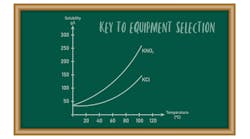Particulate solids are atoms or molecules that either are arranged in ordered arrays (crystalline), have no ordered structure beyond the short length scale (amorphous or glass), or are polymeric. Naturally, each material will exhibit its own characteristic physical properties. Disregarding the class of solids, the grinding process involves breaking bonds between individual atoms or molecules that comprise a solid. The breakage results from internal tensile or shear stresses established by the application of some external force. Grinding equipment apply various modes of external stress:
• impact,
• compression,
• shear, and
• abrasion.
Impact breaks particles based on the force applied by other particles or the impact surface. To some extent, the resulting particle size distribution (PSD) follows the existing cracks in the starting material. The force applied is limited because new particles are released following Rittinger’s Law (energy required is proportional to increase in surface area).
Compression relies on the elastic modulus to reach the yield stress and generally gives a narrower PSD because most of the force goes to the larger particles.
Shear tends to break chunks of the starting particles off from the parent material. When the internal stresses in the starting material are high (low fracture toughness), these chunks can crumble into finer particles. Shear usually is a poor use of energy because the surface-to-volume is lower than the previous modes of applied stress.
That’s where abrasion comes in. The three comminution mechanisms already mentioned have a lower limit of size whereas attrition can produce the finest particles. Attrition or erosion is a process in which a wear surface removes the atoms or molecules. Unfortunately, the wear surface often takes the worse beating. When the particle hardness is more than 20% greater than the surface hardness, we invariably get high wear. Comminution equipment usually favors one mechanism while using all of them in the overall size reduction.
The extent of fracture generally depends upon the applied method of external stress and the magnitude of this stress for a given material. It’s important to appreciate that the material’s physical properties also strongly impact the extent of fracture. In grinding equipment, the dominant method of stress application is governed by the equipment design. Consequently, understanding the fracture mechanics of a given material is crucial for specifying the correct type of equipment or determining why a mill doesn’t work properly. Sometimes we want to avoid these modes of external stress — specifically to preserve particle size (i.e., eliminate dustiness).
Materials fall into three classes: brittle, ductile or semi-brittle, with the last the most common. The physical properties of primary interest include elastic modulus, Poisson’s ratio, yield stress, hardness and fracture toughness. These are related to some extent. As an example, the ratio of yield stress and hardness is a fixed value for a given material. Usually hardness is three times the yield stress. Materials that break easily are brittle and have a high hardness and low fracture toughness. The most difficult material to grind is a ductile material because the yield stress is low and crack propagation does not occur easily. We had a polymeric chemical that was so ductile it smeared in every device that was tried. The plant had some success with a ball mill — but it took a long time to get the desired size. A short study found the hardness became much higher at lower temperatures. A pin mill worked very well when liquid nitrogen was injected during milling. Basically, we had converted this ductile material to a semi-brittle one.
While theoretical models for comminution processes exist, I generally would refrain from using these for design. I’d rather rely on the physical properties as a guide in the choice of a piece of equipment. Past experience, taking into account the physical properties of previous materials and the equipment used, is the key to selection. Given their sparse resources, most plants face difficulties in obtaining such details. So, the best bet usually is to discuss the application with established equipment manufacturers; talk to more than one because their experiences will differ and their recommendations will reflect the products they offer. (If all you have are hammers, everything looks like a nail!)


